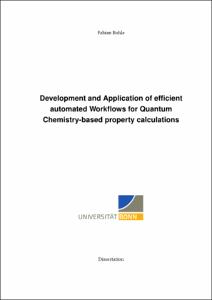Bohle, Fabian: Development and Application of efficient automated Workflows for Quantum Chemistry-based property calculations. - Bonn, 2025. - Dissertation, Rheinische Friedrich-Wilhelms-Universität Bonn.
Online-Ausgabe in bonndoc: https://nbn-resolving.org/urn:nbn:de:hbz:5-83725
Online-Ausgabe in bonndoc: https://nbn-resolving.org/urn:nbn:de:hbz:5-83725
@phdthesis{handle:20.500.11811/13285,
urn: https://nbn-resolving.org/urn:nbn:de:hbz:5-83725,
author = {{Fabian Bohle}},
title = {Development and Application of efficient automated Workflows for Quantum Chemistry-based property calculations},
school = {Rheinische Friedrich-Wilhelms-Universität Bonn},
year = 2025,
month = jul,
note = {This thesis deals with the application and development of Quantum Chemistry (QC) workflows with the aim of calculating molecular properties under standard conditions and comparing them to observables from experiments.
Many molecular systems have single bonds with a low rotation barrier, leading to molecules that exist in differently populated conformations. Knowledge of low-lying three-dimensional structures is a prerequisite for calculating molecular properties. In order to obtain these conformations, i.e., minima on the potential energy surface (PES) of the system, the PES must be explored exhaustively. The associated very high number of single-point and gradient calculations required for this conformational search makes it only feasible for fast force-field (GFN-FF) or efficient semi-empirical extended tight-binding (GFNn-xTB) methods that offer a good trade between computational speed and accuracy. The resulting structural ensemble is the starting point for refining the low-lying spatial structures in terms of both geometry and Gibbs energy. This is addressed with the development of the CENSO (command-line energetic sorting) workflow. Here, filtering strategies are implemented to quickly discard irrelevant structures and to refine and identify the relevant populated structures using density functional theory based methods, such as r2SCAN-3c. The sorting steps include the treatment of solvation effects with accurate continuum solvation models and thermostatic contributions in the framework of the modified rigid-rotor-harmonic-oscillator (mRRHO) approximation. At the end of the workflow, Gibbs energies and Boltzmann weights are provided and molecular property calculations such as the calculation of optical rotation, or NMR shielding constants can be performed. The performance of the CRENSO (i.e., CREST/CENSO) computational workflow is tested using a newly compiled dataset of flexible compounds in solution (NROR28), and the calculated OR is tested against experimentally measured [α]D . It is demonstrated that the correct OR sign and magnitude were obtained in all cases, which is a tremendous achievement given the high sensitivity of OR. As a second case study, the CRENSO performance is evaluated by comparing calculated and experimental CHCl3 solution chemical shifts of a cycloalkane series from cyclobutane to cycloicosane. It is found that the conformational effects on the chemical shifts are in good agreement with the experiment and the chemical shift profile of the cycloalkane series is correctly reproduced.
In summary, this thesis expands the QC toolbox of computational chemists and provides users with workflows that reduce/condense the complexity of methods and configuration. The CREST/CENSO technology represents a robust automated approach to calculating molecular properties like OR, pKa, logP, and NMR for non-rigid molecular compounds.},
url = {https://hdl.handle.net/20.500.11811/13285}
}
urn: https://nbn-resolving.org/urn:nbn:de:hbz:5-83725,
author = {{Fabian Bohle}},
title = {Development and Application of efficient automated Workflows for Quantum Chemistry-based property calculations},
school = {Rheinische Friedrich-Wilhelms-Universität Bonn},
year = 2025,
month = jul,
note = {This thesis deals with the application and development of Quantum Chemistry (QC) workflows with the aim of calculating molecular properties under standard conditions and comparing them to observables from experiments.
Many molecular systems have single bonds with a low rotation barrier, leading to molecules that exist in differently populated conformations. Knowledge of low-lying three-dimensional structures is a prerequisite for calculating molecular properties. In order to obtain these conformations, i.e., minima on the potential energy surface (PES) of the system, the PES must be explored exhaustively. The associated very high number of single-point and gradient calculations required for this conformational search makes it only feasible for fast force-field (GFN-FF) or efficient semi-empirical extended tight-binding (GFNn-xTB) methods that offer a good trade between computational speed and accuracy. The resulting structural ensemble is the starting point for refining the low-lying spatial structures in terms of both geometry and Gibbs energy. This is addressed with the development of the CENSO (command-line energetic sorting) workflow. Here, filtering strategies are implemented to quickly discard irrelevant structures and to refine and identify the relevant populated structures using density functional theory based methods, such as r2SCAN-3c. The sorting steps include the treatment of solvation effects with accurate continuum solvation models and thermostatic contributions in the framework of the modified rigid-rotor-harmonic-oscillator (mRRHO) approximation. At the end of the workflow, Gibbs energies and Boltzmann weights are provided and molecular property calculations such as the calculation of optical rotation, or NMR shielding constants can be performed. The performance of the CRENSO (i.e., CREST/CENSO) computational workflow is tested using a newly compiled dataset of flexible compounds in solution (NROR28), and the calculated OR is tested against experimentally measured [α]D . It is demonstrated that the correct OR sign and magnitude were obtained in all cases, which is a tremendous achievement given the high sensitivity of OR. As a second case study, the CRENSO performance is evaluated by comparing calculated and experimental CHCl3 solution chemical shifts of a cycloalkane series from cyclobutane to cycloicosane. It is found that the conformational effects on the chemical shifts are in good agreement with the experiment and the chemical shift profile of the cycloalkane series is correctly reproduced.
In summary, this thesis expands the QC toolbox of computational chemists and provides users with workflows that reduce/condense the complexity of methods and configuration. The CREST/CENSO technology represents a robust automated approach to calculating molecular properties like OR, pKa, logP, and NMR for non-rigid molecular compounds.},
url = {https://hdl.handle.net/20.500.11811/13285}
}






